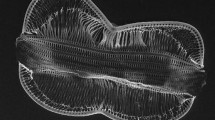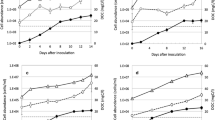Abstract
Responses of bacteria to dissolved organic carbon (DOC) released from healthy and senescent Fragilaria crotonensis (Bacillariophyceae) were examined in experimental systems. The alga released DOC actively, although the concentration fluctuated greatly in both the axenic (the alga alone) and the mixed (the alga plus the enriched bacteria) cultures. In the control (the bacteria alone) cultures, both DOC concentration and bacterial density were low and almost constant throughout the experiment: 5.0 mg C 1−1 and 1.1 × 105 cells ml−1, respectively. In the mixed cultures, bacterial growth was negligible during the exponential growth phase of the alga, but rapid proliferation of the bacteria occurred after the onset of the stationary growth phase. As the bacterial population grew, the density of senescent algal cells also increased. When the bacteria were fed on the DOC from healthy algae, their growth rate was relatively low (0.44 d−1), but the maximum cell density was high (6.4 × 105 cells ml−1). Conversely, when the bacteria fed on the DOC of senescent algae, they grew at a relatively high rate (0.51 d−1), but the maximum cell density was low (2.8 × 105 cells ml−1). These results suggest that DOCs released from dominant phytoplankton species in different physiological states affect the biomass and activity of bacteria.
Similar content being viewed by others
References
Azam, F., T. Fenchel, J. G. Field, J. S. Gray, L. A. Meyer-Reil & F. Thingstad, 1983. The role of water-column microbes in the sea. Mar. Ecol. Prog. Ser. 10: 257–263.
Bell, W. H., J. M. Lang & R. Mitchell, 1974. Selective stimulation of marine bacteria by algal extracellular products. Limnol. Oceanogr. 19: 833–839.
Bell, R. T. & J. Kuparinen, 1984. Assessing phytoplankton and bacterioplankton production during early spring in Lake Erken, Sweden. Appl. Envir. Microbiol. 48: 1221–1230.
Bradley, P. M., D. P. Cheney & N. Saga, 1988. One step antibiotic disk method for obtaining axenic cultures of multicellular marine algae. Plant cell, Tissue and Organ Culture 12: 55–60.
Cole, J. J., G. E. Likens & D. L. Strayer, 1982. Photosynthetically produced dissolved organic carbon: An important carbon source for planktonic bacteria. Limnol. Oceanogr. 27: 1080–1090.
Hellebust, J. A., 1965. Excretion of some organic compounds by marine phytoplankton. Limnol. Oceanogr. 10: 192–206.
Hino, S., 1988. Extracellular release of organic matter associated with the physiological state of freshwater blue-green algae. Arch. Hydrobiol. 113: 307–317.
Hobbie, J. E., R. J. Daley & S. Jasper, 1977. Use of Nuclepore filters for counting bacteria by fluorescence microscopy. Appl. Envir. Microbiol. 33: 1225–1228.
Kawabata, K. & M. Nakanishi. Food web structure and biodiversity in lake ecosystems. In T. Abe, S. Levin & M. Higashi (eds), Biodiversity: An ecological perspective. Springer, New York: in press.
Krog, G. F., H. Lisbeth & M. Søndergaard, 1986. Decomposition of lake phytoplankton. 2. Composition and lability of lysis products. Oikos 46: 45–50.
Lancelot, C. & G. Billen, 1984. Activity of heterotrophic bacteria and its coupling to primary production during the spring phytoplankton bloom in the southern bight of the North Sea. Limnol. Oceanogr. 29: 721–730.
Mague, T. H., E. Friberg, D. J. Hughes & I. Morris, 1980. Extracellular release of carbon by marine phytoplankton; a physiological approach. Limnol. Oceanogr. 25: 262–279.
Morikawa, K. & Y. Watanabe, 1983. Analysis of the relationships between diatom and heterotrophic bacteria isolated from a periphyton community in a river. The Faculty of General Education. 20: 107–115.
Nagata, T. & Y. Watanabe, 1990. Carbon- to nitrogen-to-volume ratios of bacterioplankton grown under different nutritional conditions. Appl. Envir. Microbiol. 56: 1303–1309.
Nakano, S., 1992. Changes in bacterioplankton production and dominant algal species in the north basin of Lake Biwa. Jpn. J. Limnol. 53: 145–149.
Nakano, S., 1994a. Carbon:nitrogen:phosphorus ratios and nutrient regeneration of a heterotrophic flagellate fed on bacteria with different elemental ratios. Arch. Hydrobiol. 129: 257–271.
Nakano, S., 1994b. Estimation of phosphorus release rate by bacterivorous flagellates in Lake Biwa. Jpn. J. Limnol. 55: 201–211.
Nalewajko, C. & D. R. S. Lean, 1972. Growth and excretion in planktonic algae and bacteria. J. Phycol. 8: 361–366.
Ohara, S., K. Fukami & Y. Ishida, 1993. Algal effects on the bacterial assemblage in Lake Biwa. Jpn. J. Limnol. 54: 261–268.
Riemann, B., 1983. Biomass and production of phyto- and bacterioplankton in eutrophic Lake Tystrup, Denmark. Freshwat. Biol. 13: 389–398.
Riemann, B. & M. Søndergaard (eds), 1986. Carbon dynamics in eutrophic temperate lakes. Elsevier Science Publishers B.V., The Netherlands.
Riquelme, C. E., K. Fukami & Y. Ishida, 1989. Growth response of bacteria to extracellular products of bloom algae. Bull. Jpn Soc. Sci. Fish. 55: 349–355.
Sanders, R. W., K. G. Porter, S. J. Bennet & A. E. DeBiase, 1989. Seasonal patterns of bacteribory by flagellates, ciliates, rotifers, and cladocerans in a freshwater planktonic community. Limnol. Oceanogr. 34: 673–687.
Sharp, J. H., 1977. Excretion of organic matter by marine phytoplankton: Do healthy cells do it? Limnol. Oceanogr. 22: 381–399.
Shiga Prefectural Institute of Public Health and Environmental Science, 1991 & 1995. Data compilation of phytoplankton in Lake Biwa, 4 and 5 (in Japanese).
Søndergaard, M. & H. H. Schierup, 1982. Release of extracellular organic carbon during a diatom bloom in Lake Mosso: molecular weight fractionation. Freshwat. Biol. 12: 313–320.
Tanaka, N., M. Nakanishi & H. Kadota, 1974. The excretion of photosynthetic product by natural phytoplankton population in Lake Biwa. Jpn. J. Limnol. 35: 91–98.
Tanaka, N., M. Nakanishi & H. Kadota, 1975. Seasonal variation of glycollateutilizing bacteria in the water column of Lake Biwa. Bull. Jpn. Soc. Sci. Fish. 41: 1129–1134.
Vadstein, O., B. O. Harkjerr, A. Jensen, Y. Olsen & H. Reinertsen, 1989. Cycling of organic carbon in the photic zone of a eutrophic lake with special reference to the heterotrophic bacteria. Limnol. Oceanogr. 34: 840–855.
Watanabe, Y., 1980. A study of the excretion and extracellular products of natural phytoplankton in Lake Nakanuma, Japan. Int. Revue ges. Hydrobiol. 65: 809–834.
Author information
Authors and Affiliations
Rights and permissions
About this article
Cite this article
Nakano, Si. Bacterial response to extracellular dissolved organic carbon released from healthy and senescent Fragilaria crotonensis (Bacillariophyceae) in experimental systems. Hydrobiologia 339, 47–55 (1996). https://doi.org/10.1007/BF00008912
Received:
Revised:
Accepted:
Issue Date:
DOI: https://doi.org/10.1007/BF00008912




